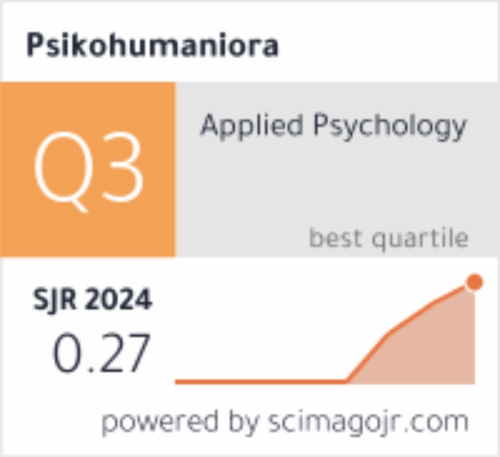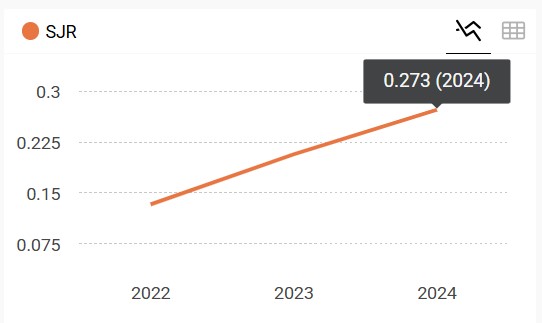Effect of Islamic-based repentance therapy on the prevention of Post-traumatic Stress Disorder (PTSD)
DOI:
https://doi.org/10.21580/pjpp.v5i2.6505Keywords:
repentance and istighfar therapy, PTSD, traffic accidentAbstract
This research is based on the tragedy of a road traffic accident that led to a student's death. Her classmates felt lost and experienced symptoms of Post-traumatic Stress Disorder (PTSD). The purpose of the study is to examine the effectiveness of repentance and istighfar therapy to prevent PTSD. The research was based on a quasi-experimental design that consisted of six sessions in three meetings and homework for four weeks. The study participants were 14 students who experienced PTSD symptoms. They completed a scale before the intervention (pre-test), after completion of the intervention (post-test), and three weeks after the post-test. The paired sample test analysis results show that there were significant differences in the trauma scores pre-therapy and post-therapy. The effect size estimation results show that the effect of repentance and istighfar therapy was in the large effect size category; that is, 80.9% of the trauma variations could be explained (caused) by repentance therapy and istighfar. The research implies that such therapy can be predicted to be effective in reducing psychological disorders, as long as they are willing to be seriously involved in each stage of the therapy process that has been determined.
Downloads
References
Adz-Dzakiey, H. B. (2007). Psikologi kenabian: Menghidupkan potensi dan kepribadian kenabian dalam diri. Pustaka Al Furqan.
American Psychiatric Association. (2013). Diagnostic and statistical manual of mental disorders (5th ed.). American Psychiatric Association. https://doi.org/10.1176/appi.books.9780890425596
Bisson, J. I., Cosgrove, S., Lewis, C., & Roberts, N. P. (2015). Post-traumatic stress disorder. BMJ, 351(6161), h6161. https://doi.org/10.1136/bmj.h6161
Casement, M. D., & Swanson, L. M. (2012). A meta-analysis of imagery rehearsal for post-trauma nightmares: Effects on nightmare frequency, sleep quality, and posttraumatic stress. Clinical Psychology Review, 32(6), 566–574. https://doi.org/10.1016/j.cpr.2012.06.002
Charuvastra, A., & Cloitre, M. (2008). Social bonds and posttraumatic stress disorder. Annual Review of Psychology, 59(1), 301–328. https://doi.org/10.1146/annurev.psych.58.110405.085650
Cohen, J. (1998). Statistical power analysis for the behavioral sciences. Routledge. https://doi.org/10.4324/9780203771587
Creamer, M., Burgess, P., & McFarlane, A. C. (2001). Post-traumatic stress disorder: Findings from the Australian national survey of mental health and well-being. Psychological Medicine, 31(7), 1237–1247. https://doi.org/10.1017/S0033291701004287
Davidson, J. R. T. (2000). Trauma: The impact of post-traumatic stress disorder. Journal of Psychopharmacology, 14(2_suppl1), S5–S12. https://doi.org/10.1177/02698811000142S102
Field, A., & Hole, G. J. (2008). How to design and report experiments. Sage Publication Inc.
al-Ghazali. (2013). Ihya Ulumiddin: Menghidupkan kembali ilmu-ilmu agama. Pintu taubat. Republika.
Gisela, V., & Kurniawan, I. N. (2014). Studi pendahuluan religiusitas Islam dan kebermaknaan hidup pasangan suami istri. Universitas Islam Indonesia, Yogyakarta.
Gravetter, F. J., & Wallnau, L. B. (2013). Statistics for behavioral sciences (9th ed.). Wadsworth, Cengage Learning.
Gros, D. F., Flanagan, J. C., Korte, K. J., Mills, A. C., Brady, K. T., & Back, S. E. (2016). Relations among social support, PTSD symptoms, and substance use in veterans. Psychology of Addictive Behaviors, 30(7), 764–770. https://doi.org/10.1037/adb0000205
Gull, F., & Dawood, S. (2013). Religiosity and subjective well-being amongst institutionalized elderly in Pakistan. Health Promotion Perspective, 3(1), 124–128. https://doi.org/10.5681/hpp.2013.014
Harits, C. N., & Kurniawan, I. N. (2016). Religiusitas Islam dan kepuasan pernikahan pasangan suami istri. Universitas Islam Indonesia, Yogyakarta.
Harris, A. H. S., Thoresen, C. E., Mccullough, M. E., & Larson, D. B. (1999). Spiritually and religiously oriented health interventions. Journal of Health Psychology, 4(3), 413–433. https://doi.org/10.1177/135910539900400309
Holliday, R., Smith, J., North, C., & Surís, A. (2015). Developing the PTSD checklist-I/F for the DSM-IV (PCL-I/F): Assessing PTSD symptom frequency and intensity in a pilot study of male veterans with combat-related PTSD. Behavioral Sciences, 5(1), 59–69. https://doi.org/10.3390/bs5010059
al-Jauziyyah, I. Q. (2014). Ensiklopedia taubat. Dari dosa menuju syurga (A. Dzulfikar (trans.)). Keira Publishing.
Kar, N. (2011). Cognitive behavioral therapy for the treatment of post-traumatic stress disorder: A review. Neuropsychiatric Disease and Treatment, 7, 167–181. https://doi.org/10.2147/NDT.S10389
Kessler, R. C., Aguilar-Gaxiola, S., Alonso, J., Benjet, C., Bromet, E. J., Cardoso, G., Degenhardt, L., de Girolamo, G., Dinolova, R. V., Ferry, F., Florescu, S., Gureje, O., Haro, J. M., Huang, Y., Karam, E. G., Kawakami, N., Lee, S., Lepine, J.-P., Levinson, D., … Koenen, K. C. (2017). Trauma and PTSD in the WHO world mental health surveys. European Journal of Psychotraumatology, 8(sup5), 1353383. https://doi.org/10.1080/20008198.2017.1353383
Keyes, K. M., Pratt, C., Galea, S., McLaughlin, K. A., Koenen, K. C., & Shear, M. K. (2014). The burden of loss: Unexpected death of a loved one and psychiatric disorders across the life course in a national study. American Journal of Psychiatry, 171(8), 864–871. https://doi.org/10.1176/appi.ajp.2014.13081132
Khairiyah, U., Prabandari, Y. S., & Uyun, Q. (2015). Terapi zikir terhadap peningkatan resiliensi penderita Low Back Pain (LBP). Jurnal Ilmiah Psikologi Terapan, 3(2), 336–346. https://doi.org/10.22219/jipt.v3i2.3537
Koenig, H. G. (2012). Religion, spirituality, and health: The research and clinical implications. ISRN Psychiatry, 1–33. https://doi.org/10.5402/2012/278730
Lang, A. J., Wilkins, K., Roy-Byrne, P. P., Golinelli, D., Chavira, D., Sherbourne, C., Rose, R. D., Bystritsky, A., Sullivan, G., Craske, M. G., & Stein, M. B. (2012). Abbreviated PTSD Checklist (PCL) as a guide to clinical response. General Hospital Psychiatry, 34(4), 332–338. https://doi.org/10.1016/j.genhosppsych.2012.02.003
Magezi, V., & Manda, C. (2016). The use of spiritual resources to cope with trauma in daily existence. In Die Skriflig/In Luce Verbi, 50(1), 2145–2154. https://doi.org/10.4102/ids.v50i1.2145
al-Naishabūry, M. bin al-Ḥajjāj A. al-Ḥasan al-Q. (n.d.). Ṣaḥīḥ Muslim. Dār al-Fikr.
Oltmanns, T. F., & Emery, R. E. (2003). Abnormal psychology. Prentice Hall.
Pearce, M., Haynes, K., Rivera, N. R., & Koenig, H. G. (2018). Spiritually integrated cognitive processing therapy: A new treatment for post-traumatic stress disorder that targets moral injury. Global Advances in Health and Medicine, 7, 216495611875993. https://doi.org/10.1177/2164956118759939
Perrin, M., Vandeleur, C. L., Castelao, E., Rothen, S., Glaus, J., Vollenweider, P., & Preisig, M. (2014). Determinants of the development of post-traumatic stress disorder, in the general population. Social Psychiatry and Psychiatric Epidemiology, 49(3), 447–457. https://doi.org/10.1007/s00127-013-0762-3
Philips, A. A. B. (1990). Salvation through repentance (an Islamic view). Riyadh: International Islamic Publishing House.
Read, J. P., Griffin, M. J., Wardell, J. D., & Ouimette, P. (2014). Coping, PTSD symptoms, and alcohol involvement in trauma-exposed college students in the first three years of college. Psychology of Addictive Behaviors, 28(4), 1052–1064. https://doi.org/10.1037/a0038348
Sareen, J. (2014). Posttraumatic stress disorder in adults: Impact, comorbidity, risk factors, and treatment. The Canadian Journal of Psychiatry, 59(9), 460–467. https://doi.org/10.1177/070674371405900902
Sijbrandij, M., Olff, M., Reitsma, J. B., Carlier, I. V. E., de Vries, M. H., & Gersons, B. P. R. (2007). Treatment of acute posttraumatic stress disorder with brief cognitive behavioral therapy: A randomized controlled trial. American Journal of Psychiatry, 164(1), 82–90. https://doi.org/10.1176/ajp.2007.164.1.82
Skelton, K., Ressler, K. J., Norrholm, S. D., Jovanovic, T., & Bradley-Davino, B. (2012). PTSD and gene variants: New pathways and new thinking. Neuropharmacology, 62(2), 628–637. https://doi.org/10.1016/j.neuropharm.2011.02.013
Trammel, R. C. (2017). Tracing the roots of mindfulness: Transcendence in Buddhism and Christianity. Journal of Religion & Spirituality in Social Work: Social Thought, 36(3), 367–383. https://doi.org/10.1080/15426432.2017.1295822
al-Utsaimin, M. B. S. (2015). Syarah riyadhus shalihin. Darus Sunnah.
Uyun, Q., & Kurniawan, I. N. (2018). Taubat (repentance) and istighfar (Seek forgiveness from Allah): Therapy to improve subjective well-being of Master Students: A preliminary study. Advanced Science Letters, 24(7), 5422–5425. https://doi.org/10.1166/asl.2018.11748
Uyun, Q., Kurniawan, I. N., & Jaufalaily, N. (2019). Repentance and seeking forgiveness: The effects of spiritual therapy based on Islamic tenets to improve mental health. Mental Health, Religion & Culture, 22(2), 185–194. https://doi.org/10.1080/13674676.2018.1514593
Uyun, Q., & Witruk, E. (2017). The effectiveness of sabr (patience) and salat (prayer) in reducing psychopathological symptoms after the 2010 Merapi eruption in the region of Yogyakarta, Indonesia. In Trends and Issues in Interdisciplinary Behavior and Social Science. CRC Press, Taylor & Francis Group.
Wainrib, B. R. (2006). Healing crisis and trauma with mind, body, and spirit. Springer Publishing Company, Inc.
Wu, B. W. Y., Gao, J., & Leung, H. K. (2019). A randomized controlled trial of Awareness Training Program (ATP), a group-based Mahayana Buddhist intervention. Mindfulness, 10, 1280–1293. https://doi.org/10.1007/s12671-0182-1
Downloads
Published
How to Cite
Issue
Section
License
The copyright of the accepted article shall be assigned to the publisher of the journal. The intended copyright includes the right to publish the article in various forms (including reprints). The journal maintains the publishing rights to published articles.
In line with the license, authors and any users (readers and other researchers) are allowed to share and adapt the material only for non-commercial purposes. In addition, the material must be given appropriate credit, provided with a link to the license, and indicated if changes were made. If authors remix, transform, or build upon the material, authors must distribute their contributions under the same license as the original.



